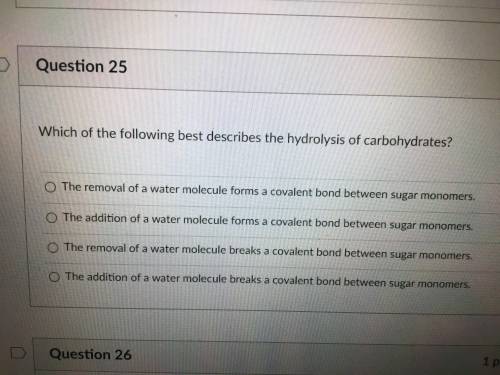
Biology, 16.10.2020 06:01 davidgritz2006
Which of the following best describes the hydrolysis of carbohydrates


Answers: 2


Other questions on the subject: Biology

Biology, 21.06.2019 18:00, melinalange48
Simulating adaptations in a species in this activity, you will discuss in detail the adaptations in a species of rain forest plants. you will build a simulation that explains the changes in the traits of the plant population over 10 years. you will also establish a scientific explanation to justify the changes in the traits of the population, * time to complete: 1-2 hours part a an organism's adaptations are specific to its native environment. an organism that lives in a coniferous forest will have different adaptations compared to an animal that lives in a tropical rain forest. the following graphs show the temperature and precipitation throughout the year for two different forests: a coniferous forest in canada, and a tropical rain forest in belize. evaluate the graphs, and then explain why plants from these two ecosystems will have different adaptations. in your answer, explain the survival challenges that plants face in these two environments.
Answers: 2

Biology, 22.06.2019 02:30, catycait27p5rc5p
What were the main components of earth’s earliest atmosphere? oxygen and ammonia hydrogen and helium oxygen and nitrogen hydrogen and nitrogen
Answers: 1

Biology, 22.06.2019 03:00, Wolfzbayne
Johnny rode his bike to a friend's house 4 blocks down the street in his neighborhood. he immediately rode back home once he realized his friend was not able to play. what was his displacement for the total bike ride? how did you determine this? what could we use as a reference point to determine he was in motion during his bike ride? why can you use it as a reference point
Answers: 1

Biology, 22.06.2019 04:00, zegangke1651
Will mark brainliest i only need the ! 1.use ten beads and a centromere of one color to construct the long chromosome. use ten beads and a centromere of a second color to construct the second chromosome in the long pair. make a drawing of the chromosomes in the space below. 2. for the second pair of chromosomes, use only five beads. 3. now model the replication of the chromosomes. make a drawing of your model in the space below. part b: meiosis i during meiosis i, the cell divides into two diploid daughter cells. 4. pair up the chromosomes to form tetrads. use the longer tetrad to model crossing-over. make a drawing of the tetrads in the space below. 5. line up the tetrads across the center of your “cell.” then model what happens to the chromosomes during anaphase i. 6. divide the cell into two daughter cells. use the space below to make a drawing of the result. part c: meiosis ii during meiosis ii, the daughter cells divide again. 7. line up the chromosomes at the center of the first cell, one above the other. separate the chromatids in each chromosome and move them to opposite sides of the cell. 8. repeat step 7 for the second cell. 9. divide each cell into two daughter cells. use the space below to make a drawing of the four haploid cells
Answers: 1
You know the right answer?
Which of the following best describes the hydrolysis of carbohydrates
...
...
Questions in other subjects:

Medicine, 13.09.2019 20:10


Mathematics, 13.09.2019 20:10




English, 13.09.2019 20:10

Mathematics, 13.09.2019 20:10





